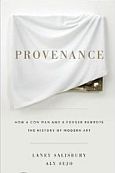If you had a choice between copies of the same book that either came with a provenance file or without one, which would you choose? The answer is a no brainer for the majority of we collectors. But what if the price was higher for the provenance file accompanied copy? How much more would you be willing to pay for that record? Certainly to own a rare medical book, for example, whose provenance lies in the former library of a doctor is to own an important piece of medical publishing history that can be quite valuable.
The history of the ownership of a rare book, especially when documented or authenticated, is held in esteem by collectors. Insinuations of a book’s previous ownership and tidbits of evidence towards its previous home all deem the specific provenance of a rare book. Is the form of provenance information significant in assessing its value? Are signatures, for example, (not necessarily of the author) more valuable than bookplates? Bookplates are themselves valuable collectibles often times, that are of interest to historians, because of their artistic designs and printing methods. Yet frequently in book descriptions sellers feel obliged to disclose that the book described does not carry any bookplates, stamps, prior owners’ signature and so forth.
Without any doubt, the most highly valued form of provenance is that which indicates an association copy or a link between an important owner of a book and its author, illustrator or contents. The association may be either through an inscription or a presentation. An inscribed copy usually carries the author’s signature along with the recipient’s name, while a presentation copy is given by the author to the recipient. In describing the form of provenance, besides making the distinction between a presentation copy and an inscribed copy, it is desirable to specify, using proper terminology, the specific details. For example, “author’s signed presentation copy” is better than “signed presentation copy,” and “author’s signed presentation copy to Ms. G…” is even better especially when Ms. G is a personality of importance.
Annotated notes found in copies which were about to be revised, as newer editions were about to be created, are another form of provenance used by historians, bibliographers, biographers and the like. Authors would sometimes annotate the copies of their books which were about to be improved, adding a whole new dimension of history, and a closer look into the author’s mind. Such annotated works offer rare glimpses into the people behind the works, and more importantly, what inspired and propelled them in their quests towards achieving a higher level of perfection.
Less common forms of provenance include embossed ownership stamps, purchase information, unusual bindings marked with initials, secret marks, coats of arms, personalized family designs and so forth. Such discreet marks are easier to identify when a considerable collection of rare books are unearthed. Common characteristics which pertain to a particular, enormous and incredibly insightful book collection allow for the research and study of a collector’s elements of provenance to be effortless, with such secret marks easier to identify.
Markings, writings, notes, stamps and so forth are a cause for some of these books to look quite ruined as previously discussed in our posting from a few weeks ago – Mutilated, Altered, Grangerized, Razored, and Bowdlerized Books. Indeed, extraneous additions to the contents of a collectible book will normally reduce its value to that of a reading copy. The exception, of course, being books with additions of the kind described above that add both historical importance and a valuable research tool of interest to the various branches of the rare book trade.


{ 0 comments… add one now }
{ 1 trackback }